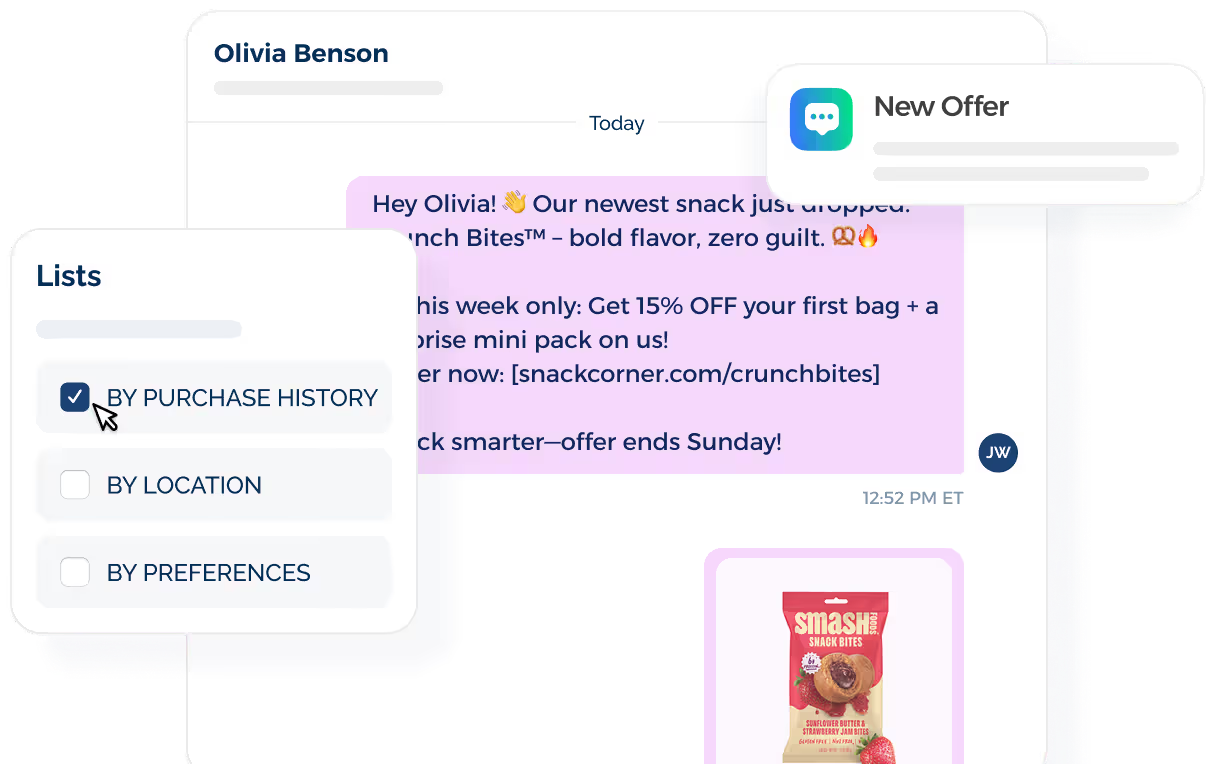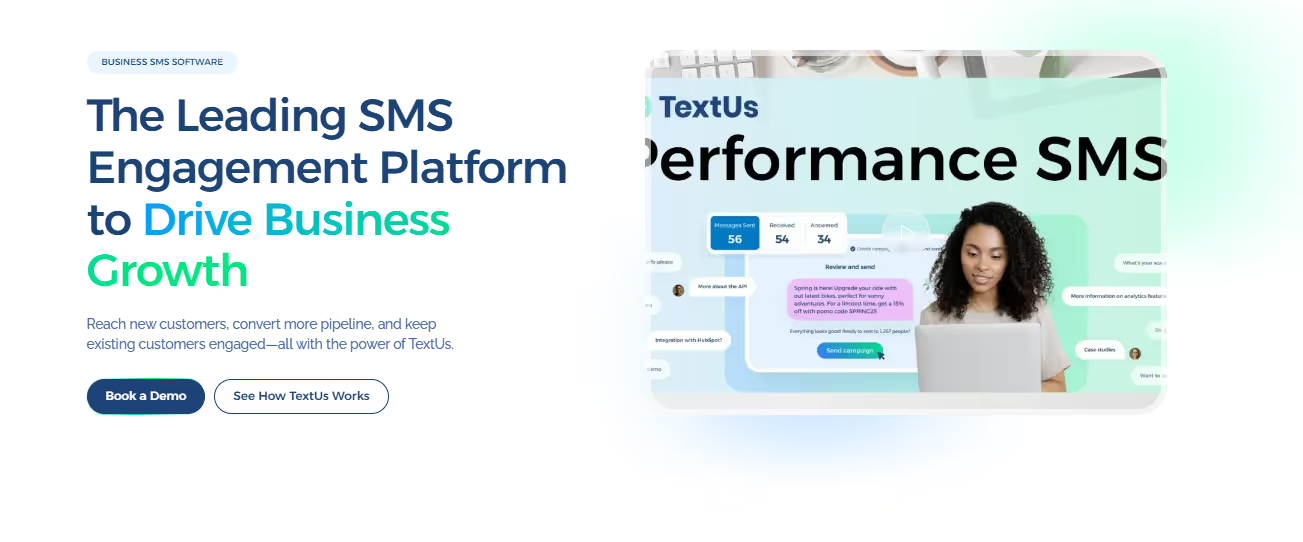How SMS Segmentation Can Personalize Your Campaigns
Learn how you can use SMS segmentation to personalize your campaigns. Discover how TextUs can help you simplify SMS marketing segmentation.
Published
October 20, 2025

SMS segmentation is what separates good text marketing from great.
When you group your audience based on shared interests, behaviors, or demographics, your messages become more relevant and personal.
Segmented campaigns consistently outperform generic mass texts in open rates, click-throughs, and conversions because they speak to what each customer values.
In this article, we’ll break down the different types of SMS segmentation and how you can use it to strengthen customer relationships and improve campaign performance.
How SMS Segmentation Works
SMS segmentation works by dividing your contact list into smaller, more defined groups so you can send each one messages that match their needs or behaviors.
It starts with data. Most businesses collect details like demographics, purchase history, engagement rates, or customer preferences through sign-up forms, surveys, or integrations with their CRM system.

This information helps you identify patterns and create segments for new customers, repeat buyers, or inactive subscribers.
Once your segments are defined, your SMS marketing software uses tags or filters to organize your audience automatically. You can then send targeted messages that align with each group’s interests.
Types of Customer Segmentation
The best approach depends on your goals, the data you have, and how you plan to communicate with your customers. Below are the most common types of SMS segmentation you can use to send more relevant and effective messages.
Demographic Segmentation
This is one of the simplest ways to segment your SMS list. It involves dividing your SMS subscribers based on basic traits such as age, gender, income, education, or occupation. These details give you a starting point for tailoring messages that match who your customers are.
If you're a retail brand, you might promote back-to-school sales to parents, send style updates to younger shoppers, or highlight premium products for higher-income groups. You can also use loyalty status or average order value as filters to personalize messages even further.
This type of customer segmentation works well because it relies on information you already collected during sign-up or through customer profiles within your SMS program.
Geographic Segmentation
Location-based segmentation focuses on where your customers are located. It allows you to tailor messages based on a subscriber’s geographic location, city, state, region, or zip code.
This approach is useful if you have physical locations, regional promotions, or location-specific services.
If you run a restaurant chain, you might text a lunch special only to customers near a certain branch. If you’re in the retail industry, you could promote a seasonal sale in warmer climates while advertising winter gear to shoppers in colder areas.
Even service-based businesses can use location data to remind local clients about appointments or events happening nearby through this communication channel.
Behavioral Segmentation
This method focuses on how each subscriber interacts with your brand, such as their actions, habits, and engagement patterns. When you understand what people do rather than just who they are, you can send messages that match their intent and timing.
You can group your target subscribers based on purchase history, website activity, or response to previous campaigns. As a clothing store, you might send a thank-you discount code to repeat buyers, while a salon could remind clients when it’s time to book their next appointment.
This type of segmentation helps build loyalty and increase conversions because your messages feel timely and relevant. Instead of sending the same messages to everyone, each text reflects where the customer is in their customer journey and what they’re likely to do next.
Lifecycle Segmentation
Every customer goes through different stages, from signing up to becoming a repeat buyer, to potentially going inactive. This segmentation method lets you tailor messages to each stage and effectively segment your audience based on lifecycle activity.
You might send a warm welcome message to new subscribers, share product recommendations with recent buyers, or offer a special promotion to re-engage inactive customers. You can even integrate segmentation with your loyalty program to reward ongoing participation.
It also helps maintain consistent customer engagement over time, since your audience receives messages that fit where they are rather than months ago. Using segment filters and segmentation rules can help automate this process to keep your lists organized.
Interest-Based Segmentation
This approach helps you connect with your audience on a more personal level by focusing on what they care about. It uses engagement data collected from surveys, purchase history, browsing activity, or interactions with past campaigns.
If you're a beauty brand, you can create campaigns that send skincare tips to customers who previously bought moisturizers. At the same time, another group receives makeup-related offers through SMS and marketing channels like email or social media.
Psychographic Segmentation
Psychographics look beyond surface-level data like age or location and focus on what drives your customers, which is their values, beliefs, lifestyles, and motivations. It helps you understand why people buy, not just who they are.
This type of segmentation is used for building emotional connections through SMS marketing.
If you're a fitness brand, you might send motivational messages to subscribers focused on wellness and discipline, while another group receives lifestyle content centered around balance and self-care.
Best SMS Segmentation Strategies to Maximize Reach
Successful SMS segmentation depends on how well you manage your data, craft your messages, and maintain consistency across campaigns. Here are some proven best practices to help you get the most out of your efforts.
Collect Quality Data
The quality of the information you collect affects how well you can group and target your audience.
Start by gathering details that help you understand who your SMS subscribers are and how they interact with your brand. Sign-up forms, purchase histories, customer surveys, and website activity are all valuable sources.
It’s also important to keep your data up to date. People change phone numbers, move to new locations, or shift their interests over time. Regularly reviewing and refreshing your subscriber information makes sure your SMS content stays accurate and effective.
Keep Segments Manageable
While it’s tempting to create a segment for every possible customer trait, over-dividing your audience makes campaign management complicated.
The goal of SMS segments is to improve personalization, not overwhelm your process. Focus on different groups such as customer behavior, location, or purchase activity.
A few well-defined groups are far more effective than dozens of narrow ones that are hard to track and maintain. It also helps to regularly review your segment filters to see which ones deliver results and increase engagement.
Use Automation Wisely
SMS automation can take your text message marketing from manual and time-consuming to efficient. With the right tools, you can automatically group contacts, trigger messages based on behavior, and update segments based on real-time actions.
For example, automation can identify when a customer makes a purchase and instantly move them into a recent buyer segment. It can also detect cart abandonment and trigger a re-engagement message after a set period.
These automated workflows save time while ensuring that each subscriber receives the right message at the right moment, based on their customer journey and engagement.
However, automation should improve your strategy, not replace thoughtful communication. Always review your workflows and test your triggers to make sure messages sound personal rather than repetitive.
Stay Compliant With Regulations
Compliance isn’t the most exciting part of SMS segmentation, but it’s one of the most important. You must follow regulations to protect your business and your customers while keeping your campaigns legitimate.
The Telephone Consumer Protection Act (TCPA) in the United States sets rules for how businesses can collect, store, and use customer data. These laws also require that subscribers give consent before receiving text messages and that they can easily opt out at any time.
When building your SMS contact list, always use opt-in forms and keep records of when and how each subscriber gave permission. Avoid purchasing contact lists or sending unsolicited messages, as these practices can lead to fines and damage your brand reputation.
It’s also a good idea to review your messaging practices regularly to ensure ongoing text message compliance, especially if you operate in multiple marketing channels with different legal requirements.
Personalize Without Overdoing It
Personalization is what makes customer engagement through SMS so powerful. But there’s a fine line between being personal and being intrusive. Crossing that line can quickly push customers away.
A little personalization goes a long way. You can use first names in messages, reference product launches, or tailor special offers based on past interactions.
These small touches show that you understand your target subscribers without making your texts feel overly targeted or uncomfortable.
What you want to avoid is referencing details that customers didn’t intentionally share. This can come off as invasive and damage trust.
Keep Lists Clean and Updated
Over time, phone numbers change, customers lose interest, or contacts become inactive. If you don’t maintain your list, you risk sending messages to people who aren’t engaged or to numbers that no longer exist.
Regular list maintenance keeps your campaigns efficient and your costs under control. You need to remove duplicate entries, invalid numbers, and subscribers who haven’t interacted for a long time.
It’s also a good practice to monitor subscriber engagement and periodically invite subscribers to confirm their interest. A simple “Still want to hear from us?” message can help ensure your list stays current and compliant.
Test and Refine Your Segments
Even the best SMS marketing strategy needs regular testing and fine-tuning. Customer behavior changes and trends evolve, so what worked before might not perform as well today.
Start by running A/B testing on your other marketing channels and segmented campaigns. Try a few ways of testing message length, time zone delivery, or entry point offers to see which combinations perform best.
You can track metrics like open rates, click-through rates, and average order value to identify what resonates with your audience.
You should also pay attention to feedback and patterns of customer segmentation. If a certain segment consistently underperforms, it might need to be redefined or combined with another group.
Likewise, if you notice new opportunities, don’t hesitate to create campaigns that capture fresh interest or promote upcoming local events and loyalty programs.
Experience the Simplicity of SMS Marketing Segmentation—Try TextUs!
Are you still sending the same text to everyone on your SMS list? Without smart segmentation, your texts get lost and you miss the chance to start real conversations that lead to action.
TextUs makes it easy to segment your audience and send campaigns at the optimal time. With intuitive tools and built-in automation, you can group contacts by location, behavior, or level of engagement.
This SMS platform helps you personalize communication, whether you’re nurturing leads, following up with customers, or coordinating with your team. Each text feels targeted and perfectly timed without extra complexity.

Start building stronger relationships and get more out of every message you send. Book a demo with TextUs and experience how smarter segmentation can turn simple texts into two-way conversations!
FAQs About SMS Segmentation
What is SMS segmentation?
SMS segmentation is the process of dividing your target audience into smaller groups based on shared traits or behaviors. This allows you to send more relevant content and personalized messages instead of sending the same text to everyone.
For example, you might segment your audience by location, buying habits, or engagement levels to make sure each message feels targeted and timely. This approach helps you boost engagement and create text messages that speak directly to your subscribers.
What are the four types of segmentation?
The four primary types of segmentation used in marketing are:
- Demographic segmentation: Groups customers based on age, gender, income, or occupation
- Geographic segmentation: Targets people based on where they live or work
- Behavioral segmentation: Focuses on customer actions such as purchase history or engagement
- Psychographic segmentation: Groups people based on lifestyle, interests, values, or motivations
Each type gives you a unique way to understand your audience and tailor your text marketing strategy.
What is an SMS message segment?
An SMS message segment refers to how text messages are counted and billed by mobile carriers. A single SMS typically includes up to 160 characters when using standard text encoding (GSM-7).
If your message exceeds that limit or includes special characters or emojis, it’s automatically split into multiple segments.
Each segment counts as a separate message for billing and delivery purposes, something to consider when offering early access promotions or limited-time deals.
What are the five stages of segmentation?
The five stages of segmentation describe the process businesses use to create effective audience groups:
- Identify your audience: Gather data from customer sign-ups, purchases, or behavior
- Determine segmentation criteria: Decide which characteristics or actions to use for grouping
- Create segments: Organize contacts into specific categories or tags
- Target segments: Craft messages tailored to each group’s needs or interests
- Review and refine: Analyze performance data and update your segments to stay accurate and effective
This process keeps your SMS segmentation strategy structured, consistent, and results-driven.
Continue Reading
Frequently Asked Questions
Business Texting
Built for Results
Create and convert pipeline at scale through industry leading SMS software




